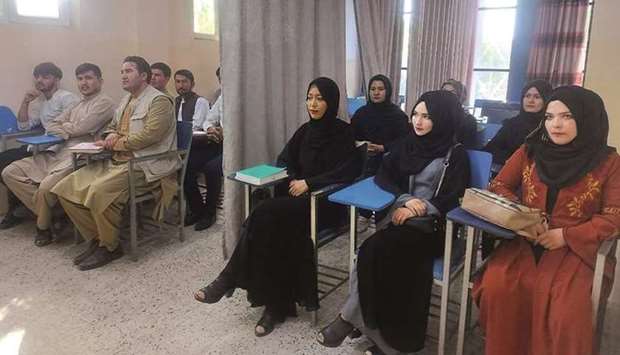Students across Afghanistan have started returning to university for the first time since the Taliban stormed to power, and in some cases females have been separated from their male peers by curtains or boards down the middle of the classroom.
What happens in universities and schools across the country is being closely watched by foreign powers, who want the Taliban to respect the rights of women in return for vital aid and diplomatic engagement.
When it last ruled from 1996-2001, the group banned girls from school and women from university and work.
Despite assurances in recent weeks that women’s rights would be honoured in accordance with Islamic law, it is unclear what that will mean in practice.
Teachers and students at universities in Afghanistan’s largest cities – Kabul, Kandahar and Herat – told Reuters that female students were being segregated in class, taught separately or restricted to certain parts of the campus.
“Putting up curtains is not acceptable,” Anjila, a 21-year-old student at Kabul University who returned to find her classroom partitioned, told Reuters by telephone. “I really felt terrible when I entered the class ... we are gradually going back to 20 years ago.”
Even before the Taliban took over Afghanistan, Anjila said female students sat separately from males.
However, classrooms were not physically divided.
A document outlining guidelines for resuming class circulated by an association of private universities in Afghanistan listed measures such as the mandatory wearing of hijabs and separate entrances for female students.
It also said female teachers should be hired to teach female students, and that females should be taught separately or, in smaller classes, segregated by a curtain.
It was unclear if the document, seen by Reuters, represented official Taliban policy.
The group’s spokesperson did not immediately comment on the document, on photographs of divided classrooms or on how universities would be run.
“Our students don’t accept this and we will have to close the university,” said Noor Ali Rahmani, the director of Gharjistan University in Kabul, on an almost empty campus.
“Our students wear the hijab, not the niqab,” he added, referring to a head scarf.
The Taliban’s education authority issued a lengthy document on Sunday outlining their measures for the classroom, which also ruled that men and women should be segregated – or at least divided by a curtain if there are 15 students or less.
“We said we didn’t accept it because it will be difficult to do,” Rahmani told AFP.
The Taliban said last week that schooling should resume but that males and females should be separated.
A senior Taliban official told Reuters that classroom dividers such as curtains were “completely acceptable”, and that given Afghanistan’s “limited resources and manpower” it was best to “have the same teacher teaching both sides of a class”.
Photographs shared by Avicenna University in Kabul, and widely circulated on social media, show a grey curtain running down the centre of the classroom, with female students wearing long robes and head coverings but their faces visible.
Several teachers said there was uncertainty over what rules would be imposed under the Taliban, who have yet to form a government more than three weeks after they seized Kabul with barely a shot fired in anger.
Their return to power has alarmed some women, who fear they will lose the rights they fought for in the last two decades, in the face of resistance from many families and officials in the deeply conservative Muslim country.
A journalism professor at Herat University in the west of the country told Reuters that he decided to split his one-hour class into two halves, first teaching females and then males.
Of 120 students enrolled for his course, less than a quarter showed up at school yesterday.
A number of students and teachers have fled the country, and the fate of the country’s thriving private media sector has suddenly been thrown into doubt.
“Students were very nervous today,” he said. “I told them to just keep coming and keep studying and in the coming days the new government will set the rules.”
For some students, however, it was a relief that women would still be able to attend university at all under a new Taliban regime.
Zuhra Bahman, who runs a scholarship programme for women in Afghanistan, said on social media that she had spoken to some of the students.
“They are happy to go back to university, albeit in hijab,” she said. “Taliban opening universities for women is a key progress. Let’s continue to engage to agree on other rights and freedoms.”
For 28-year-old computer science student Amir Hussein, “everything changed completely” after the Taliban takeover.
“Many students are not interested anymore in studying because they don’t know what their future will be,” he said. “Most of them want to leave Afghanistan.”

Students attend class under new classroom conditions at Kabul’s Avicenna University.
